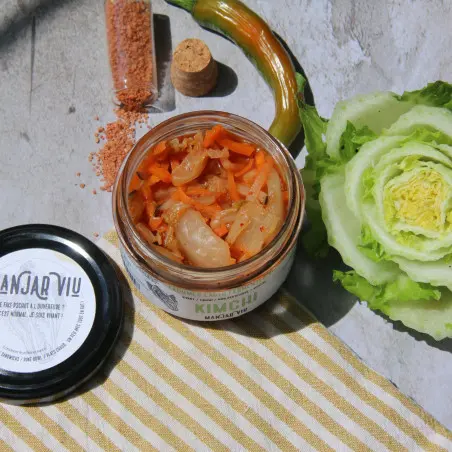Lactofermentation:
Fermentation is a very ancient preservation process found in many countries. It involves transforming organic matter by microorganisms such as bacteria and yeasts. These organisms are called "anaerobic" because they develop in the absence of oxygen in the form of dioxygen.
Different foods that some of us consume daily are fermented, such as sourdough bread, beer, cider, wine, vinegar, pickles, yogurts, cheese, kefir, sausage, sausages, olives, sauerkraut. But also tea, cocoa, and coffee. Among fermented items, there are also many products of Asian origin: soy sauce, miso, nuoc-mâm, umeboshi plums, etc.
There are two main types of fermentation: alcoholic fermentation (wine, cider, beer...) and lacto-fermentation (or lactic fermentation), which owes its name to the so-called "lactic" bacteria.
Instructions (lactic fermentation):
Cut cabbage leaves into thin strips. Place them in a jar, making sure to pack them tightly. Mix everything with a spoonful of sea salt, preferably unrefined. Then close the jar, ensuring that the vegetables remain well below the surface of the liquid, allowing the gases produced to escape. Let ferment for at least 2 weeks before tasting. The lactic ferments will be responsible for the transformations the cabbage will undergo. This process will be the same for other vegetables.
Preferably use organic vegetables, especially since lactic bacteria seem to develop better with organically grown vegetables.
The lacto-fermentation produces lactic acid. It is a fermentation produced by lactic bacteria.
In vegetables and fruits, there are fermentable sugars that, in the absence of air when covered with water or their own juice, will enter a lacto-fermentation process.
At the end of this transformation (due to the acidity: pH 4), microorganisms no longer develop. Thus, pathogenic bacteria are inactivated or even killed. This is why lacto-fermented foods benefit from very long preservation.

What are the benefits of lacto-fermented vegetables?
- Antiseptic effect that blocks the development of microorganisms.
- Antibiotic effect through the production of antibacterial substances that particularly act on pathogenic bacteria.
- Promotes the balance and proper functioning of our intestinal flora (or microbiota) through the production of lactic bacteria, which constitute a family of microorganisms of which the intestine is an immense reservoir. Let's not forget that our health is very intimately dependent on the quality of our intestinal flora.
- Production of B vitamins, beneficial for the nervous system, skin, etc.
- New organoleptic flavor often appreciated.
- Neutralization of undesirable molecules for health contained in certain foods. This is the case with fermented soy, which makes the food more assimilable, but still to be consumed in moderation (tamari, shoyu, miso…).
NOTE:
It is good to remember that lacto-fermented foods being acidic should be consumed in moderation, especially in people with an acidic demineralized condition. Consumption of lacto-fermented products may be discouraged for people with digestive disorders (intestinal bloating, gas, etc.) associated with intestinal dysbiosis.
Since lacto-fermented foods are rich in nutrients sensitive to heat, they are preferably consumed raw. In case of intestinal bloating, it may be advisable to eliminate them at least for a while.
Without talking about miraculous food, it is not an exaggeration to think that a healthy, balanced, and non-toxic living diet, containing an important source of active nutrients such as raw vegetables, fruits, and vegetables in their whole form, associated with juices from these same foods (for an additional supply of different active principles), helps to avoid or correct many various health disorders.













